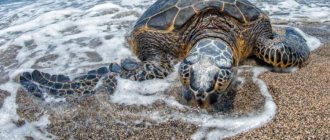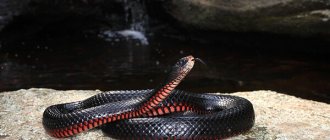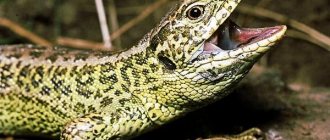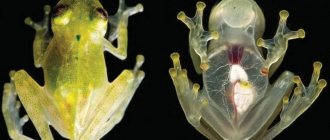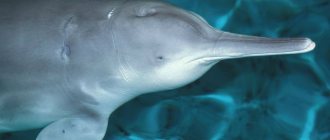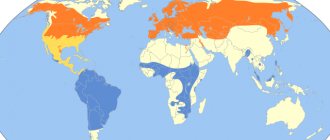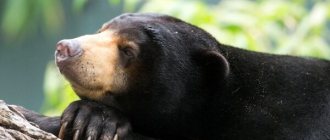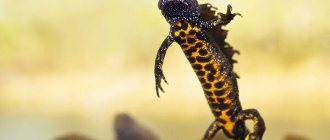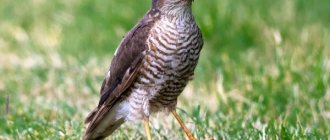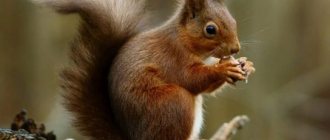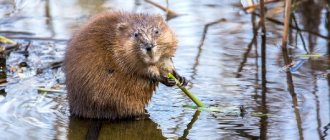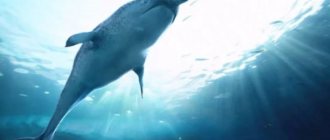Description of loggerhead
The loggerhead belongs to sea turtles that are quite large in body size, having a carapace 0.79-1.20 m long and weighing in the range of 90-135 kg or slightly more. The front flippers are equipped with a pair of blunt claws. In the area of the back of the marine animal there are five pairs, represented by costal scutes. Juveniles have three characteristic longitudinal keels.
Appearance
The vertebrate reptile has a massive and rather short head with a rounded muzzle area . The head of the sea animal is covered with large scutes. The jaw muscles are characterized by power, which makes it possible to quite easily and quickly crush even very thick shells and shells of prey, represented by various marine invertebrates.
The front flippers have pairs of blunt claws. Four prefrontal shields are located in front of the animal's eyes. The number of edge shields can vary from twelve to fifteen pieces.
The carapace is brown, reddish-brown or olive in color, and the color of the plastron is yellow or creamy. The skin of a vertebrate reptile is reddish-brown in color. Males have a long tail.
Lifestyle of a turtle
Loggerheads are excellent swimmers not only on the surface, but also underwater. The sea turtle generally does not need to be on land for long periods of time. Such a marine vertebrate reptile is capable of staying at a sufficient distance from the coastline for a long time. Most often, the animal is found many hundreds of kilometers from the coastline, and rests afloat.
This is interesting! Loggerheads flock en masse towards the shores of an island or the nearest mainland exclusively during the breeding season.
Lifespan
Despite fairly good health and a significant life expectancy, contrary to a very common and generally accepted opinion, loggerheads are not at all different. On average, such vertebrate reptiles live about three decades.
Return to content
Captivity
Why did we talk about her life in captivity? So that special lovers of exotic things come up with the idea of having this monster as a pet. This is possible, but it will require keeping a snapping turtle in such a way that only people with enormous incomes can afford it; this is a very expensive pleasure. Otherwise, you should take a closer look at, for example, Trionics.
Terrarium
Forget about the usual standard aquarium, the snapping turtle grows throughout its life. It is more profitable to immediately buy a huge aquaterrarium so that it will last a lifetime.
Turtle in a huge aquarium
Or is it better to immediately make a small fenced pond, this is for a particularly financially secure stratum of the population.
If your choice is an aquaterrarium, then you must comply with the following requirements:
- Dimensions 2x1x1 meters. This is the minimum, otherwise the turtle simply won’t be able to turn around there;
- Install two lamps - one fluorescent, for illumination, and the second - ultraviolet, marked UVB 10%. All reptiles require UV radiation, and ours is no exception. Duration of irradiation – 12 hours every day;
- At the bottom there must be a thick layer of soil, sand, silt, or other decorative elements in which the animal can burrow;
- The temperature should be kept at 25 degrees, not higher;
- Be sure to have a very powerful filter that works around the clock. Without it, the animal will dirty everything around in just a couple of days;
- There must be an island of land;
- The size of the stones should be 3 times larger than the animal's head, otherwise it may begin to swallow them.
Turtle buries itself in the muddy bottom
Naturally, there should be no other animals within the reach of its beak, even if it is a large animal. The turtle will not tolerate his neighbor and will eat him, maybe not right away, but it’s a matter of time.
You need to pick up an adult specimen by the back of its shell and hold it firmly, taking into account its weight and the strength of its paws, because she will certainly break out.
What does a snapping turtle eat?
There is only one answer to this question - the turtle eats everything that moves in front of its nose. If there are no living inhabitants, she will begin to snack on plants. You can also pamper the biter with all kinds of vegetables, fruits, chilled fish, meat, in general, anything that can be chewed (most importantly, not with your fingers). The only exceptions are poisonous animals and plants.
But, if I may put it this way, people pay them in the same coin, and the meat of the snapping turtle in Asian countries is considered a delicacy; they say that the soup with its meat is very tasty.
Safety precautions when communicating
Learn one rule - no snapping turtle has ever been domesticated. You can pick it up only as a last resort, when, for example, you need to replant and wash the aquaterrarium. They start biting from birth, so wear thick gloves.
It is also advisable that the turtle is well-fed, then the desire to bite will be less.
Teenage turtle
But not everyone can boast that in their home lives a creature that appeared on Earth long before the advent of dinosaurs, and which, with proper care, can be boasted of for about 60 years - that’s how long they live in captivity.
And remember - we are responsible for those we have tamed! Even if they are not tameable.
Range and habitats
Loggerhead turtles have a circumglobal distribution. Almost all nesting sites of such reptiles are located in subtropical and temperate regions. With the exception of the western Caribbean, large marine animals are most often found north of the Tropic of Cancer and in the southern part of the zone from the Tropic of Capricorn.
This is interesting! In the course of mitochondrial DNA studies, it was possible to establish that representatives of different nests have pronounced genetic differences, so it is assumed that females of this species tend to return to lay eggs precisely in the places of their birth.
According to research, individual turtles of this species can be found in the north in temperate or arctic waters, in the Barents Sea, as well as in the area of the La Plata and Argentina bays. The vertebrate reptile prefers to settle in estuaries, fairly warm coastal waters or brackish marshes.
Return to content
Classification
- Subfamily Carettinae
- Genus Caretta
Species Caretta caretta - loggerhead, or loggerhead sea turtle, or caretta, or loggerhead turtle- loggerhead sea turtles or loggerhead sea turtles
- Species Lepidochelys olivacea
- olive turtle, or olive ridley
Genus Lepidochelys
- ridley, or olive turtles Species
Lepidochelys kempii
- Atlantic ridley
- Genus Chelonia
Species Chelonia mydas - green turtle, or green sea turtle, or soup turtle- green turtles, or soup turtles
- Genus Eretmochelys
Species Eretmochelys imbricata - hawksbill, or hawksbill- bissy
- Genus Natator
Species Natator depressus (formerly Chelonia depressa) - Australian green turtle
Extinct representatives:
- † Itilochelys rasstrigin
is an extinct species of turtle that lived in the Volgograd region of Russia about 63 million years ago.
It was described on the basis of a partial skeleton (partial skull with lower jaw, cervical vertebrae). Genus † Puppigerus
Species †
Puppigerus camperi - Species † Puppigerus nessovi
Loggerhead nutrition
Loggerhead turtles are classified as large marine predators . This species is omnivorous, and this fact is undoubtedly an undeniable advantage. Thanks to this feature, it is much easier for large sea reptiles to find prey and provide themselves with sufficient food.
Loggerhead turtles most often feed on a variety of invertebrates, crustaceans and mollusks, including jellyfish and large snails, sponges and squid. The loggerhead's diet also includes fish and seahorses, and sometimes even includes various seaweeds, but the animal gives preference to sea zoster.
Return to content
Food
It feeds mainly on marine invertebrates - mollusks (for example, mussels) and crustaceans (for example, crabs), as well as fish, jellyfish, sponges, echinoderms (starfish). Occasionally, the loggerhead also eats aquatic plants. Sea turtles keep the jellyfish population at a relatively stable level. To get bottom dwellers like crabs, loggerhead turtles have to sift through sand to find their prey. By doing this, they mix and aerate the sand, ensuring that nutrients are distributed throughout the sediment.
Reproduction and offspring
The loggerhead breeding season is in the summer and autumn. Loggerhead turtles, in the process of migrating to breeding grounds, are able to swim distances reaching 2000-2500 km. It is during the period of migration that the process of active courtship of males with females occurs.
At this time, males lightly bite females in the neck or shoulder area. Mating occurs regardless of the time of day, but always on the water surface. After mating, the females swim to the nesting site, after which they wait until nightfall and only then leave the sea water.
The reptile crawls very clumsily along the surface of sandbanks, going beyond the tide of sea waves. Nests are made in the driest places on the coast, and are primitive, not too deep holes, which females dig out with the help of strong hind limbs.
As a rule, the clutch size of a loggerhead varies between 100-125 eggs. The eggs laid are round in shape and have a leathery shell. The hole with the eggs is buried in sand, after which the females quickly crawl into the sea. The reptile returns to its nesting site every two to three years.
This is interesting! Loggerhead sea turtles reach full puberty quite late, so they are able to reproduce only in the tenth year of life, and sometimes later.
The development process of turtle hatchlings takes about two months, but can vary depending on weather conditions and environmental characteristics. At a temperature of 29-30°C, development accelerates and a significant number of females are born. In the cooler season, more males are born, and the development process itself slows down significantly.
The birth of turtles inside the same nest is almost simultaneous . After birth, newborn turtles rake the sandy blanket with their paws and move towards the sea. During the movement, a significant number of juveniles die, becoming easy prey for large seabirds or terrestrial predatory animals. During their first year of life, young turtles live in kelp beds.
Return to content
Caspian turtle in your home
This breed is quite unpretentious, so it is popular among pet lovers. The only thing is that you have to take into account its large size.
If you are negligent in caring for your turtle, it will simply get sick and die. Therefore, carefully read the basic requirements for caring for this wonderful creature.
Large terrarium
At home, turtles usually live in a terrarium - a place similar to an aquarium, but with a small island on which the animal can dry out and warm up.
However, Caspian turtles love water most of all. They stay in it most of the time, swim perfectly at depth and even sleep underwater. Therefore, the filter must be turned on at all times for turtles. The water should be changed at least 1-2 times a week.
Also keep an eye on the water temperature. It should be from +18 OS to +23 OS. The air temperature in the terrarium is about +30 °C.
Little turtles
Babies, up to 10 centimeters in size, can live together with fish and plants. However, as they age, they will eat all the vegetation. Therefore, take care to transplant the turtles to a separate place.
Baby Caspian turtle
At home, turtles are active all day, but when evening comes, they fall asleep, sinking to the bottom. Wintering also takes place. They do not need to hibernate in a terrarium.
Natural enemies
Natural enemies that reduce the number of vertebrate reptiles include not only predators, but also people who actively interfere with the personal space of such a representative of marine flora. Of course, such an animal is not exterminated for its meat or shell, but the eggs of this reptile are considered a delicacy, which are very widely used in cooking, added to desserts and sold smoked.
Loggerhead hunting is now prohibited in many countries, including Italy, Greece and Cyprus, but there are still areas where loggerhead turtle eggs are used as a popular and highly sought after aphrodisiac.
Also, the main negative factors influencing the noticeable decrease in the overall population of such marine reptiles include changes in climatic conditions and the settlement of beach coastlines.
Return to content
Interesting facts about the animal
- It is still unknown where turtles originated from.
- Sea carriages navigate in space according to the Earth's magnetic field. They use this skill during migrations: after many years they sail to exactly the place where they were once born.
- Amphibians recognize and remember human faces.
- The size of the female affects the number of eggs she can lay at one time.
- While swimming, amphibians gain speed up to 35 km/h.
- Greater loggerheads understand the language of dolphins.
Meaning for humans
Loggerhead turtles are absolutely safe for humans . In recent years, there has been a trend toward keeping the loggerhead as an exotic pet.
This is interesting! Cubans extract loggerhead eggs from pregnant females, smoke them inside the oviducts and sell them as a kind of sausage, and in Colombia they are used to prepare sweet dishes.
There are a lot of people who want to acquire such an unusual animal, but a sea reptile purchased for home keeping is doomed to a certain and painful death, since it is almost impossible to independently provide such an aquatic inhabitant with a full-fledged space.
Return to content
National Marine Park in Zakynthos
To preserve the turtle population in Zakynthos, the National Marine Park was founded in 1999. Its main task is to preserve the ecosystem and create conditions for increasing the population of Caretta Caretta turtles. The National Park includes 6 beaches of Laganos Bay, the small islands of Marathonissi and Pelouzo. About 3,000 turtle nests appear here every year, which are monitored by park staff and volunteers.
Turtle nests on the beaches of Laganos
Not only turtles, but Mediterranean seals monachus-monachus are under close attention.
Population and species status
Loggerheads are listed as a vulnerable species in the Red Data Book and are also listed under the Convention as prohibited animals for international trade. The marine vertebrate reptile is a protected species according to the national laws of countries such as America, Cyprus, Italy, Greece and Turkey.
It should also be noted that the rules of the international airport on the island of Zakynthos prohibit the take-off and landing of aircraft from 00:00 to 04:00. This rule is due to the fact that during the night hours on the sands of Laganas beach, located near of this airport, loggerheads lay eggs en masse.
Return to content
What kind of organization is Archelon?
Sea turtles have been endangered for many years. This is due to many factors: environmental pollution, fishing nets, the development of hotels in coastal areas and the development of beaches. And since about 60% of the nests of Caretta caretta sea turtles are located in Greece, the Archelon Association is doing everything possible to preserve these reptiles, which are rapidly disappearing from our planet.
Archelon (ΑΡΧΕΛΩΝ) is a Greek society for the protection of sea turtles, which was created in 1983. The society works in the main nesting areas of Caretta caretta turtles in Greece: the island of Crete, the Peloponnese peninsula and the island of Zakynthos. Volunteers from Archelon rescue sick and injured turtles, and also educate people about rare reptiles by conducting public excavations of nests.
